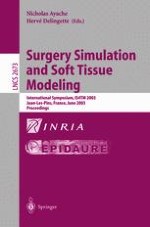2003 | Buch
Surgery Simulation and Soft Tissue Modeling
International Symposium, IS4TM 2003 Juan-Les-Pins, France, June 12–13, 2003, Proceedings
herausgegeben von: Nicholas Ayache, Hervé Delingette
Verlag: Springer Berlin Heidelberg
Buchreihe : Lecture Notes in Computer Science
Enthalten in: Professional Book Archive
